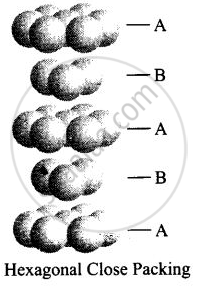Advertisements
Advertisements
प्रश्न
Which of the following statement is not true about the hexagonal close packing?
विकल्प
The coordination number is 12.
It has 74% packing efficiency.
Tetrahedral voids of the second layer are covered by the spheres of the third layer.
In this arrangement spheres of the fourth layer are exactly aligned with those of the first layer.
उत्तर
In this arrangement spheres of the fourth layer are exactly aligned with those of the first layer.
Explanation:
Hexagonal close packing can be arranged by two layers
A and B one over another which can be diagrammatically represented as
Here, we can see easily that 1st layer and 4th layer are not exactly aligned. Thus, statement (iv) is not correct while other statements (i), (ii) and (iii) are true.
APPEARS IN
संबंधित प्रश्न
Ferric oxide crystallises in a hexagonal close-packed array of oxide ions with two out of every three octahedral holes occupied by ferric ions. Derive the formula of the ferric oxide.
Aluminium crystallises in a cubic close-packed structure. Its metallic radius is 125 pm.
(i) What is the length of the side of the unit cell?
(ii) How many unit cells are there in 1.00 cm3 of aluminium?
Hexagonal close packed arrangement of ions is described as ____________.
What is the coordination number in a square close packed structure in two dimensions?
In the SF4 molecule, there are:
Which of the following is frenkal effect.
The number of tetrahedral and octahedral voids in a CCP array of 100 atoms are respectively:
Element 'B' forms ccp structures and A occupies half of the octahedral voids, while oxygen atoms occupy all the tetrahedral voids. The structure of bimetallic oxide is ______.
The empirical formula for a compound with a cubic close packed arrangement of anions and with cations occupying all the octahedral sites in AxB. The value of x is ______. (Integer answer)
The density of a pure substance 'X' whose atoms pack in cubic close pack arrangement is 1 g/cc. If all tetrahedral voids are occupied by 'Y' atoms. The value of '3a' is ______ g/cc, if the density of resulting solid is 'a' g/cc.
[Given: Atomic mass (X) = 30 g/mol, (Y) = 20 g/mol]
